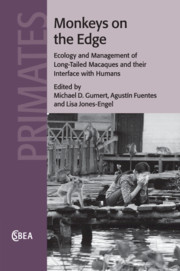Book contents
- Frontmatter
- Contents
- List of contributors
- Foreword
- Preface
- Acknowledgements
- Part I The status and distribution of long-tailed macaques
- Part II The human–macaque interface
- Part III Ethnophoresy of long-tailed macaques
- 8 Macaca fascicularis in Mauritius: Implications for macaque–human interactions and for future research on long-tailed macaques
- 9 The support of conservation programs through the biomedical usage of long-tailed macaques in Mauritius
- 10 Ethnophoresy: The exotic macaques of Ngeaur Island, Republic of Palau
- Part IV Comparisons with rhesus macaques
- Part V Understanding and managing the human–macaque interface
- Index
- References
9 - The support of conservation programs through the biomedical usage of long-tailed macaques in Mauritius
from Part III - Ethnophoresy of long-tailed macaques
Published online by Cambridge University Press: 16 May 2011
- Frontmatter
- Contents
- List of contributors
- Foreword
- Preface
- Acknowledgements
- Part I The status and distribution of long-tailed macaques
- Part II The human–macaque interface
- Part III Ethnophoresy of long-tailed macaques
- 8 Macaca fascicularis in Mauritius: Implications for macaque–human interactions and for future research on long-tailed macaques
- 9 The support of conservation programs through the biomedical usage of long-tailed macaques in Mauritius
- 10 Ethnophoresy: The exotic macaques of Ngeaur Island, Republic of Palau
- Part IV Comparisons with rhesus macaques
- Part V Understanding and managing the human–macaque interface
- Index
- References
Summary
Introduction
Mauritius is a 1,865 m2 oceanic island found within the Mascarene archipelago in the Indian Ocean some 900 km east of Madagascar around latitude 20o15' S and longitude 57o30'E with the highest point of the island being at 828 m above sea level (Saddul,1995). (Figure 9.1).
Although found on Arab mariner charts as early as 1300 AD and visited since then by sailors of various origins, such as the Portuguese, it was only colonized by the Dutch in 1638 AD (Cheke and Hume, 2008). After the Dutch, the island was colonized by the French followed by the British before attaining independence in 1968. Mauritius has had a Republic status since 1992 and a population of 1.26M (CSO, 2007), making it the eighteenth most densely populated country in the world. The official language is English, but the local dialect, the Mauritian Creole, is closer to French, making the latter a more used language than English. The Mauritian population is ethnically very diverse with people of Indian origin (68 percent), descended mostly from the indentured laborers from India composed of people from different religious backgrounds – Hindus, Muslims, Tamils, Telegus, Marathis, etc. The next largest ethnic group is composed of Creoles (27 percent) – people descended mostly from slaves brought over from Madagascar and Africa. People of Chinese origin, mostly descended from Chinese immigrants from Guangzhou compose 3 percent of the population and the remaining 2 percent are made of people of European descent (mostly from France) and some other minorities.
- Type
- Chapter
- Information
- Monkeys on the EdgeEcology and Management of Long-Tailed Macaques and their Interface with Humans, pp. 236 - 251Publisher: Cambridge University PressPrint publication year: 2011
References
- 2
- Cited by

